HEALTH VARIATION.
VerifiedAdded on 2023/01/17
|7
|2153
|20
AI Summary
Contribute Materials
Your contribution can guide someone’s learning journey. Share your
documents today.
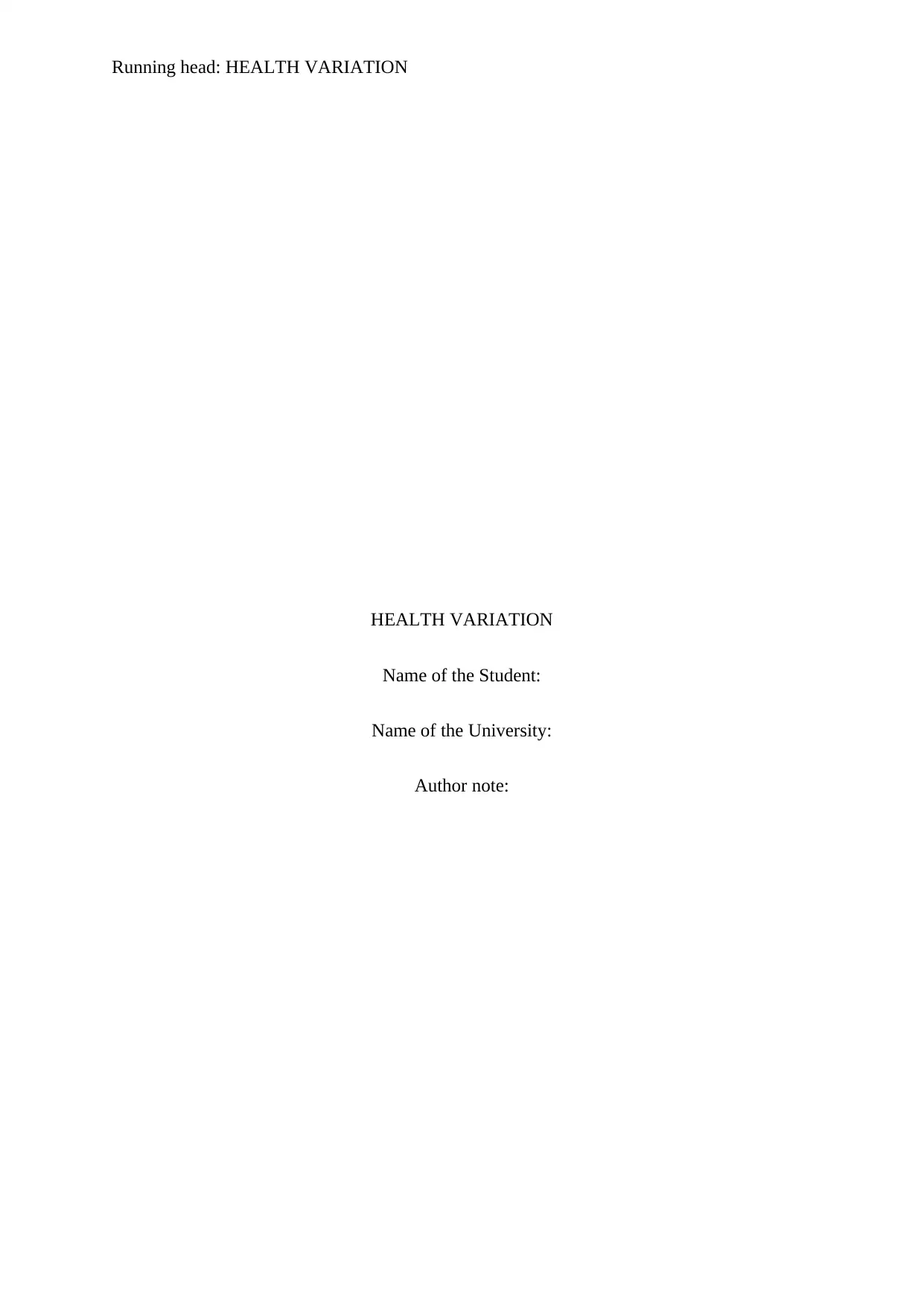
Running head: HEALTH VARIATION
HEALTH VARIATION
Name of the Student:
Name of the University:
Author note:
HEALTH VARIATION
Name of the Student:
Name of the University:
Author note:
Secure Best Marks with AI Grader
Need help grading? Try our AI Grader for instant feedback on your assignments.
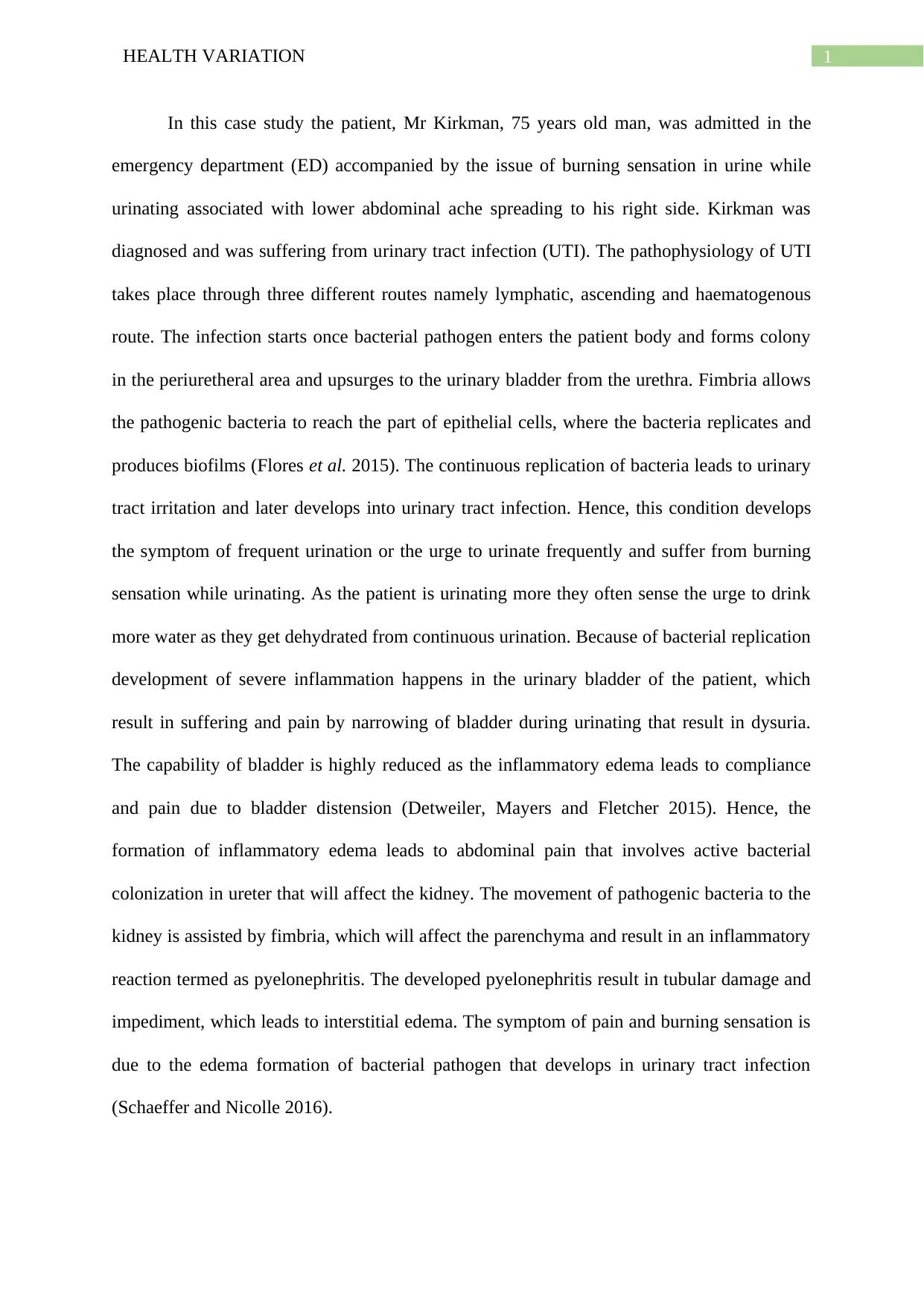
1HEALTH VARIATION
In this case study the patient, Mr Kirkman, 75 years old man, was admitted in the
emergency department (ED) accompanied by the issue of burning sensation in urine while
urinating associated with lower abdominal ache spreading to his right side. Kirkman was
diagnosed and was suffering from urinary tract infection (UTI). The pathophysiology of UTI
takes place through three different routes namely lymphatic, ascending and haematogenous
route. The infection starts once bacterial pathogen enters the patient body and forms colony
in the periuretheral area and upsurges to the urinary bladder from the urethra. Fimbria allows
the pathogenic bacteria to reach the part of epithelial cells, where the bacteria replicates and
produces biofilms (Flores et al. 2015). The continuous replication of bacteria leads to urinary
tract irritation and later develops into urinary tract infection. Hence, this condition develops
the symptom of frequent urination or the urge to urinate frequently and suffer from burning
sensation while urinating. As the patient is urinating more they often sense the urge to drink
more water as they get dehydrated from continuous urination. Because of bacterial replication
development of severe inflammation happens in the urinary bladder of the patient, which
result in suffering and pain by narrowing of bladder during urinating that result in dysuria.
The capability of bladder is highly reduced as the inflammatory edema leads to compliance
and pain due to bladder distension (Detweiler, Mayers and Fletcher 2015). Hence, the
formation of inflammatory edema leads to abdominal pain that involves active bacterial
colonization in ureter that will affect the kidney. The movement of pathogenic bacteria to the
kidney is assisted by fimbria, which will affect the parenchyma and result in an inflammatory
reaction termed as pyelonephritis. The developed pyelonephritis result in tubular damage and
impediment, which leads to interstitial edema. The symptom of pain and burning sensation is
due to the edema formation of bacterial pathogen that develops in urinary tract infection
(Schaeffer and Nicolle 2016).
In this case study the patient, Mr Kirkman, 75 years old man, was admitted in the
emergency department (ED) accompanied by the issue of burning sensation in urine while
urinating associated with lower abdominal ache spreading to his right side. Kirkman was
diagnosed and was suffering from urinary tract infection (UTI). The pathophysiology of UTI
takes place through three different routes namely lymphatic, ascending and haematogenous
route. The infection starts once bacterial pathogen enters the patient body and forms colony
in the periuretheral area and upsurges to the urinary bladder from the urethra. Fimbria allows
the pathogenic bacteria to reach the part of epithelial cells, where the bacteria replicates and
produces biofilms (Flores et al. 2015). The continuous replication of bacteria leads to urinary
tract irritation and later develops into urinary tract infection. Hence, this condition develops
the symptom of frequent urination or the urge to urinate frequently and suffer from burning
sensation while urinating. As the patient is urinating more they often sense the urge to drink
more water as they get dehydrated from continuous urination. Because of bacterial replication
development of severe inflammation happens in the urinary bladder of the patient, which
result in suffering and pain by narrowing of bladder during urinating that result in dysuria.
The capability of bladder is highly reduced as the inflammatory edema leads to compliance
and pain due to bladder distension (Detweiler, Mayers and Fletcher 2015). Hence, the
formation of inflammatory edema leads to abdominal pain that involves active bacterial
colonization in ureter that will affect the kidney. The movement of pathogenic bacteria to the
kidney is assisted by fimbria, which will affect the parenchyma and result in an inflammatory
reaction termed as pyelonephritis. The developed pyelonephritis result in tubular damage and
impediment, which leads to interstitial edema. The symptom of pain and burning sensation is
due to the edema formation of bacterial pathogen that develops in urinary tract infection
(Schaeffer and Nicolle 2016).
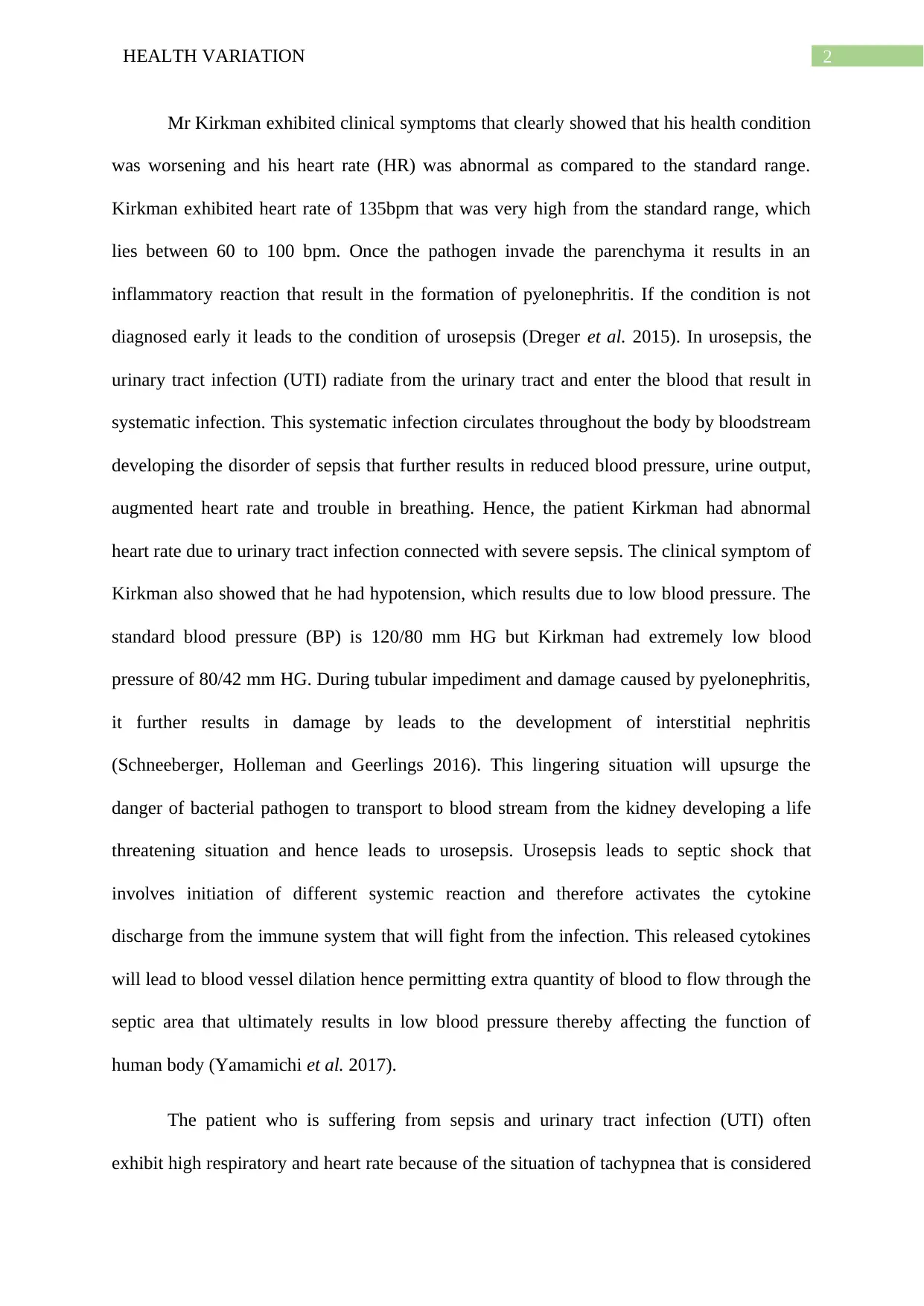
2HEALTH VARIATION
Mr Kirkman exhibited clinical symptoms that clearly showed that his health condition
was worsening and his heart rate (HR) was abnormal as compared to the standard range.
Kirkman exhibited heart rate of 135bpm that was very high from the standard range, which
lies between 60 to 100 bpm. Once the pathogen invade the parenchyma it results in an
inflammatory reaction that result in the formation of pyelonephritis. If the condition is not
diagnosed early it leads to the condition of urosepsis (Dreger et al. 2015). In urosepsis, the
urinary tract infection (UTI) radiate from the urinary tract and enter the blood that result in
systematic infection. This systematic infection circulates throughout the body by bloodstream
developing the disorder of sepsis that further results in reduced blood pressure, urine output,
augmented heart rate and trouble in breathing. Hence, the patient Kirkman had abnormal
heart rate due to urinary tract infection connected with severe sepsis. The clinical symptom of
Kirkman also showed that he had hypotension, which results due to low blood pressure. The
standard blood pressure (BP) is 120/80 mm HG but Kirkman had extremely low blood
pressure of 80/42 mm HG. During tubular impediment and damage caused by pyelonephritis,
it further results in damage by leads to the development of interstitial nephritis
(Schneeberger, Holleman and Geerlings 2016). This lingering situation will upsurge the
danger of bacterial pathogen to transport to blood stream from the kidney developing a life
threatening situation and hence leads to urosepsis. Urosepsis leads to septic shock that
involves initiation of different systemic reaction and therefore activates the cytokine
discharge from the immune system that will fight from the infection. This released cytokines
will lead to blood vessel dilation hence permitting extra quantity of blood to flow through the
septic area that ultimately results in low blood pressure thereby affecting the function of
human body (Yamamichi et al. 2017).
The patient who is suffering from sepsis and urinary tract infection (UTI) often
exhibit high respiratory and heart rate because of the situation of tachypnea that is considered
Mr Kirkman exhibited clinical symptoms that clearly showed that his health condition
was worsening and his heart rate (HR) was abnormal as compared to the standard range.
Kirkman exhibited heart rate of 135bpm that was very high from the standard range, which
lies between 60 to 100 bpm. Once the pathogen invade the parenchyma it results in an
inflammatory reaction that result in the formation of pyelonephritis. If the condition is not
diagnosed early it leads to the condition of urosepsis (Dreger et al. 2015). In urosepsis, the
urinary tract infection (UTI) radiate from the urinary tract and enter the blood that result in
systematic infection. This systematic infection circulates throughout the body by bloodstream
developing the disorder of sepsis that further results in reduced blood pressure, urine output,
augmented heart rate and trouble in breathing. Hence, the patient Kirkman had abnormal
heart rate due to urinary tract infection connected with severe sepsis. The clinical symptom of
Kirkman also showed that he had hypotension, which results due to low blood pressure. The
standard blood pressure (BP) is 120/80 mm HG but Kirkman had extremely low blood
pressure of 80/42 mm HG. During tubular impediment and damage caused by pyelonephritis,
it further results in damage by leads to the development of interstitial nephritis
(Schneeberger, Holleman and Geerlings 2016). This lingering situation will upsurge the
danger of bacterial pathogen to transport to blood stream from the kidney developing a life
threatening situation and hence leads to urosepsis. Urosepsis leads to septic shock that
involves initiation of different systemic reaction and therefore activates the cytokine
discharge from the immune system that will fight from the infection. This released cytokines
will lead to blood vessel dilation hence permitting extra quantity of blood to flow through the
septic area that ultimately results in low blood pressure thereby affecting the function of
human body (Yamamichi et al. 2017).
The patient who is suffering from sepsis and urinary tract infection (UTI) often
exhibit high respiratory and heart rate because of the situation of tachypnea that is considered

3HEALTH VARIATION
as the chief clinical symptom of urinary tract infection related with sever sepsis. In the
condition of severe sepsis, the immunity system of the patient to compete against the foreign
bacterial pathogen decreases that reduces the overall blood flow rate hence making the
immune system less effective (Keren et al. 2015). The pathogenic bacteria injures the vital
organs of the patient and also reduces the supply of rich oxygenated blood that escalates the
oxygen demand in order to breathe normally, which results in the condition of prompt
breathing and abnormal or high respiratory rate (RR). Kirkman had fever or high body
temperature of 39 degree Celsius. The standard temperature of human body is considered in
the range of 36.1 to 37.2 degree Celsius. In urinary tract infection (UTI) connected with
severe sepsis, the human body competes with the invading bacterial pathogen by systemic
response or reaction that results in heating up or high body temperature termed as fever
(Gupta, Grigoryan and Trautner 2017). Therefore, it can be established from the complete
clinical symptoms that Kirkman’s health was worsening as he had urinary tract infection
(UTI) connected with acute sepsis, which required immediate medical consideration and
attention.
The suitable nursing strategy recommended for Kirkman will help him to recover
from his deteriorating condition of acute sepsis and urinary tract infection. The first nursing
strategy is to assess the clinical symptoms or indications of urinary tract infection (UTI) and
evaluate the identified risk factors connected with sepsis and UTI. The symptoms include
fever, chills, sense of burning while urinating and cloudy urine. The identified risk factor
from assessment will support the healthcare professional to recognize the primary causes that
lead to infection and detect the precise symptom of their health condition (Mody et al. 2015).
The second most significant nursing strategy is to preserve an acidic surrounding in the
bladder by consuming agents such as Mandelamine and vitamin C, which is considered and
recognized as the primary antiseptic agent of treating urinary tract infection (UTI). The
as the chief clinical symptom of urinary tract infection related with sever sepsis. In the
condition of severe sepsis, the immunity system of the patient to compete against the foreign
bacterial pathogen decreases that reduces the overall blood flow rate hence making the
immune system less effective (Keren et al. 2015). The pathogenic bacteria injures the vital
organs of the patient and also reduces the supply of rich oxygenated blood that escalates the
oxygen demand in order to breathe normally, which results in the condition of prompt
breathing and abnormal or high respiratory rate (RR). Kirkman had fever or high body
temperature of 39 degree Celsius. The standard temperature of human body is considered in
the range of 36.1 to 37.2 degree Celsius. In urinary tract infection (UTI) connected with
severe sepsis, the human body competes with the invading bacterial pathogen by systemic
response or reaction that results in heating up or high body temperature termed as fever
(Gupta, Grigoryan and Trautner 2017). Therefore, it can be established from the complete
clinical symptoms that Kirkman’s health was worsening as he had urinary tract infection
(UTI) connected with acute sepsis, which required immediate medical consideration and
attention.
The suitable nursing strategy recommended for Kirkman will help him to recover
from his deteriorating condition of acute sepsis and urinary tract infection. The first nursing
strategy is to assess the clinical symptoms or indications of urinary tract infection (UTI) and
evaluate the identified risk factors connected with sepsis and UTI. The symptoms include
fever, chills, sense of burning while urinating and cloudy urine. The identified risk factor
from assessment will support the healthcare professional to recognize the primary causes that
lead to infection and detect the precise symptom of their health condition (Mody et al. 2015).
The second most significant nursing strategy is to preserve an acidic surrounding in the
bladder by consuming agents such as Mandelamine and vitamin C, which is considered and
recognized as the primary antiseptic agent of treating urinary tract infection (UTI). The
Secure Best Marks with AI Grader
Need help grading? Try our AI Grader for instant feedback on your assignments.
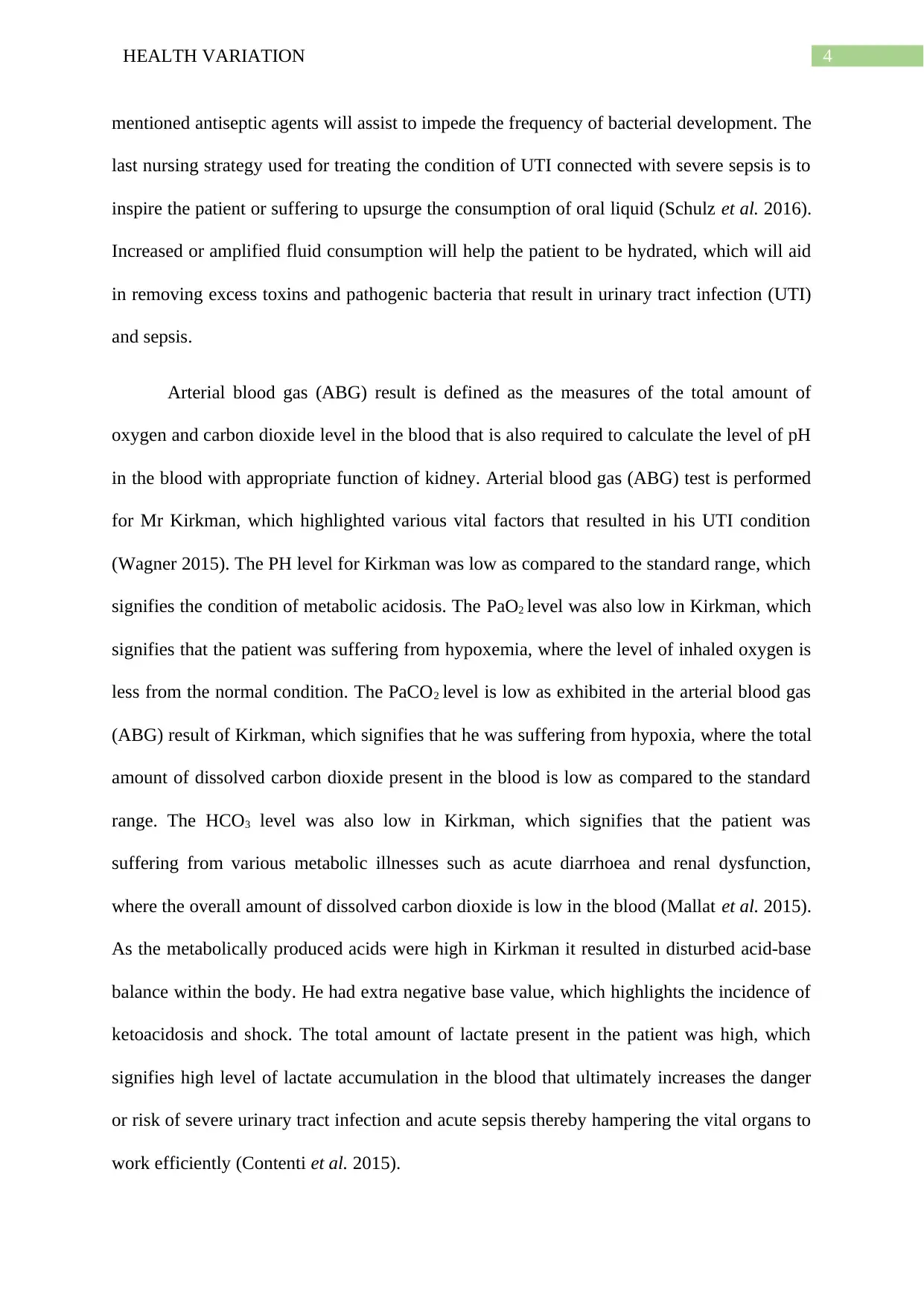
4HEALTH VARIATION
mentioned antiseptic agents will assist to impede the frequency of bacterial development. The
last nursing strategy used for treating the condition of UTI connected with severe sepsis is to
inspire the patient or suffering to upsurge the consumption of oral liquid (Schulz et al. 2016).
Increased or amplified fluid consumption will help the patient to be hydrated, which will aid
in removing excess toxins and pathogenic bacteria that result in urinary tract infection (UTI)
and sepsis.
Arterial blood gas (ABG) result is defined as the measures of the total amount of
oxygen and carbon dioxide level in the blood that is also required to calculate the level of pH
in the blood with appropriate function of kidney. Arterial blood gas (ABG) test is performed
for Mr Kirkman, which highlighted various vital factors that resulted in his UTI condition
(Wagner 2015). The PH level for Kirkman was low as compared to the standard range, which
signifies the condition of metabolic acidosis. The PaO2 level was also low in Kirkman, which
signifies that the patient was suffering from hypoxemia, where the level of inhaled oxygen is
less from the normal condition. The PaCO2 level is low as exhibited in the arterial blood gas
(ABG) result of Kirkman, which signifies that he was suffering from hypoxia, where the total
amount of dissolved carbon dioxide present in the blood is low as compared to the standard
range. The HCO3 level was also low in Kirkman, which signifies that the patient was
suffering from various metabolic illnesses such as acute diarrhoea and renal dysfunction,
where the overall amount of dissolved carbon dioxide is low in the blood (Mallat et al. 2015).
As the metabolically produced acids were high in Kirkman it resulted in disturbed acid-base
balance within the body. He had extra negative base value, which highlights the incidence of
ketoacidosis and shock. The total amount of lactate present in the patient was high, which
signifies high level of lactate accumulation in the blood that ultimately increases the danger
or risk of severe urinary tract infection and acute sepsis thereby hampering the vital organs to
work efficiently (Contenti et al. 2015).
mentioned antiseptic agents will assist to impede the frequency of bacterial development. The
last nursing strategy used for treating the condition of UTI connected with severe sepsis is to
inspire the patient or suffering to upsurge the consumption of oral liquid (Schulz et al. 2016).
Increased or amplified fluid consumption will help the patient to be hydrated, which will aid
in removing excess toxins and pathogenic bacteria that result in urinary tract infection (UTI)
and sepsis.
Arterial blood gas (ABG) result is defined as the measures of the total amount of
oxygen and carbon dioxide level in the blood that is also required to calculate the level of pH
in the blood with appropriate function of kidney. Arterial blood gas (ABG) test is performed
for Mr Kirkman, which highlighted various vital factors that resulted in his UTI condition
(Wagner 2015). The PH level for Kirkman was low as compared to the standard range, which
signifies the condition of metabolic acidosis. The PaO2 level was also low in Kirkman, which
signifies that the patient was suffering from hypoxemia, where the level of inhaled oxygen is
less from the normal condition. The PaCO2 level is low as exhibited in the arterial blood gas
(ABG) result of Kirkman, which signifies that he was suffering from hypoxia, where the total
amount of dissolved carbon dioxide present in the blood is low as compared to the standard
range. The HCO3 level was also low in Kirkman, which signifies that the patient was
suffering from various metabolic illnesses such as acute diarrhoea and renal dysfunction,
where the overall amount of dissolved carbon dioxide is low in the blood (Mallat et al. 2015).
As the metabolically produced acids were high in Kirkman it resulted in disturbed acid-base
balance within the body. He had extra negative base value, which highlights the incidence of
ketoacidosis and shock. The total amount of lactate present in the patient was high, which
signifies high level of lactate accumulation in the blood that ultimately increases the danger
or risk of severe urinary tract infection and acute sepsis thereby hampering the vital organs to
work efficiently (Contenti et al. 2015).
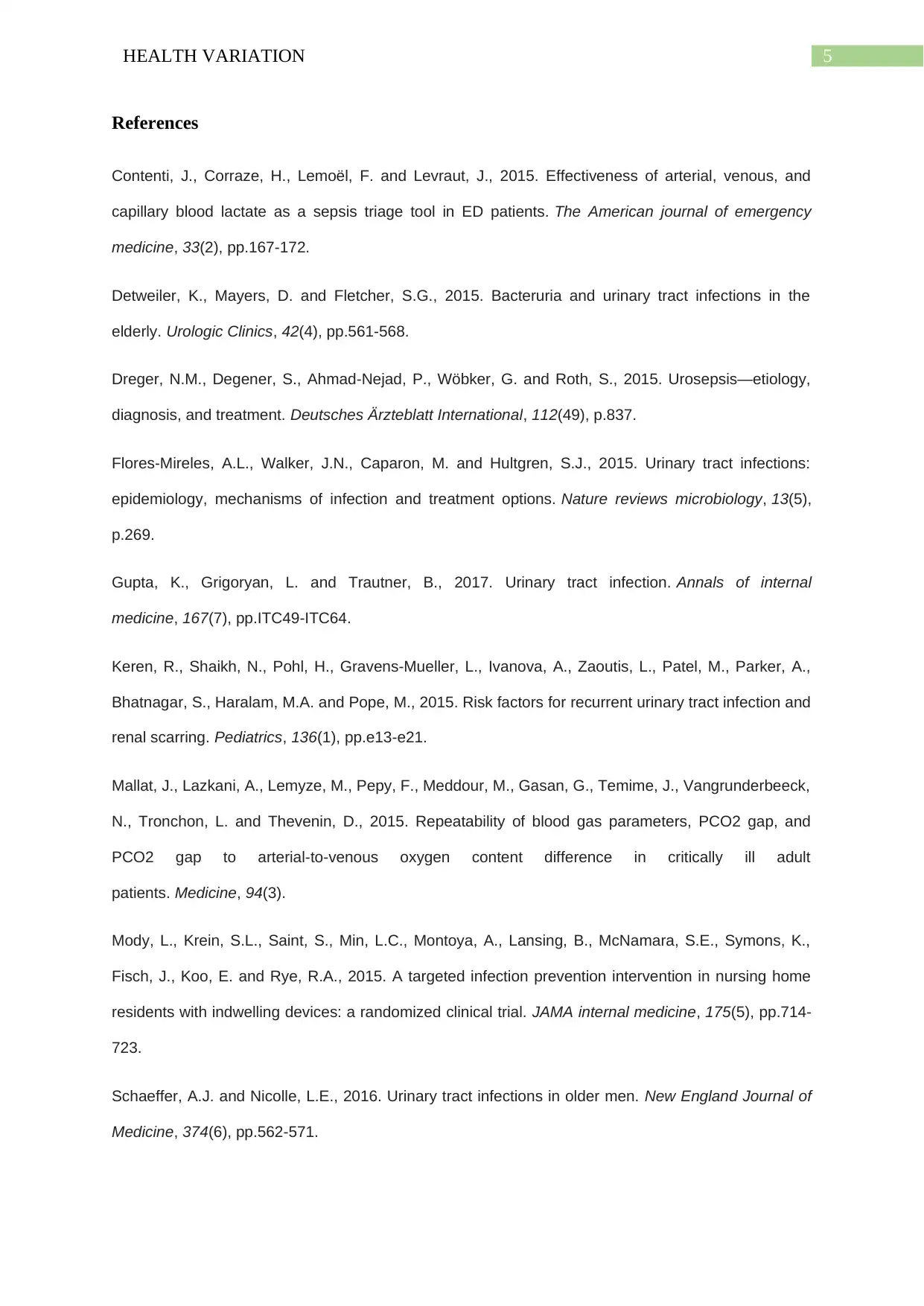
5HEALTH VARIATION
References
Contenti, J., Corraze, H., Lemoël, F. and Levraut, J., 2015. Effectiveness of arterial, venous, and
capillary blood lactate as a sepsis triage tool in ED patients. The American journal of emergency
medicine, 33(2), pp.167-172.
Detweiler, K., Mayers, D. and Fletcher, S.G., 2015. Bacteruria and urinary tract infections in the
elderly. Urologic Clinics, 42(4), pp.561-568.
Dreger, N.M., Degener, S., Ahmad-Nejad, P., Wöbker, G. and Roth, S., 2015. Urosepsis—etiology,
diagnosis, and treatment. Deutsches Ärzteblatt International, 112(49), p.837.
Flores-Mireles, A.L., Walker, J.N., Caparon, M. and Hultgren, S.J., 2015. Urinary tract infections:
epidemiology, mechanisms of infection and treatment options. Nature reviews microbiology, 13(5),
p.269.
Gupta, K., Grigoryan, L. and Trautner, B., 2017. Urinary tract infection. Annals of internal
medicine, 167(7), pp.ITC49-ITC64.
Keren, R., Shaikh, N., Pohl, H., Gravens-Mueller, L., Ivanova, A., Zaoutis, L., Patel, M., Parker, A.,
Bhatnagar, S., Haralam, M.A. and Pope, M., 2015. Risk factors for recurrent urinary tract infection and
renal scarring. Pediatrics, 136(1), pp.e13-e21.
Mallat, J., Lazkani, A., Lemyze, M., Pepy, F., Meddour, M., Gasan, G., Temime, J., Vangrunderbeeck,
N., Tronchon, L. and Thevenin, D., 2015. Repeatability of blood gas parameters, PCO2 gap, and
PCO2 gap to arterial-to-venous oxygen content difference in critically ill adult
patients. Medicine, 94(3).
Mody, L., Krein, S.L., Saint, S., Min, L.C., Montoya, A., Lansing, B., McNamara, S.E., Symons, K.,
Fisch, J., Koo, E. and Rye, R.A., 2015. A targeted infection prevention intervention in nursing home
residents with indwelling devices: a randomized clinical trial. JAMA internal medicine, 175(5), pp.714-
723.
Schaeffer, A.J. and Nicolle, L.E., 2016. Urinary tract infections in older men. New England Journal of
Medicine, 374(6), pp.562-571.
References
Contenti, J., Corraze, H., Lemoël, F. and Levraut, J., 2015. Effectiveness of arterial, venous, and
capillary blood lactate as a sepsis triage tool in ED patients. The American journal of emergency
medicine, 33(2), pp.167-172.
Detweiler, K., Mayers, D. and Fletcher, S.G., 2015. Bacteruria and urinary tract infections in the
elderly. Urologic Clinics, 42(4), pp.561-568.
Dreger, N.M., Degener, S., Ahmad-Nejad, P., Wöbker, G. and Roth, S., 2015. Urosepsis—etiology,
diagnosis, and treatment. Deutsches Ärzteblatt International, 112(49), p.837.
Flores-Mireles, A.L., Walker, J.N., Caparon, M. and Hultgren, S.J., 2015. Urinary tract infections:
epidemiology, mechanisms of infection and treatment options. Nature reviews microbiology, 13(5),
p.269.
Gupta, K., Grigoryan, L. and Trautner, B., 2017. Urinary tract infection. Annals of internal
medicine, 167(7), pp.ITC49-ITC64.
Keren, R., Shaikh, N., Pohl, H., Gravens-Mueller, L., Ivanova, A., Zaoutis, L., Patel, M., Parker, A.,
Bhatnagar, S., Haralam, M.A. and Pope, M., 2015. Risk factors for recurrent urinary tract infection and
renal scarring. Pediatrics, 136(1), pp.e13-e21.
Mallat, J., Lazkani, A., Lemyze, M., Pepy, F., Meddour, M., Gasan, G., Temime, J., Vangrunderbeeck,
N., Tronchon, L. and Thevenin, D., 2015. Repeatability of blood gas parameters, PCO2 gap, and
PCO2 gap to arterial-to-venous oxygen content difference in critically ill adult
patients. Medicine, 94(3).
Mody, L., Krein, S.L., Saint, S., Min, L.C., Montoya, A., Lansing, B., McNamara, S.E., Symons, K.,
Fisch, J., Koo, E. and Rye, R.A., 2015. A targeted infection prevention intervention in nursing home
residents with indwelling devices: a randomized clinical trial. JAMA internal medicine, 175(5), pp.714-
723.
Schaeffer, A.J. and Nicolle, L.E., 2016. Urinary tract infections in older men. New England Journal of
Medicine, 374(6), pp.562-571.
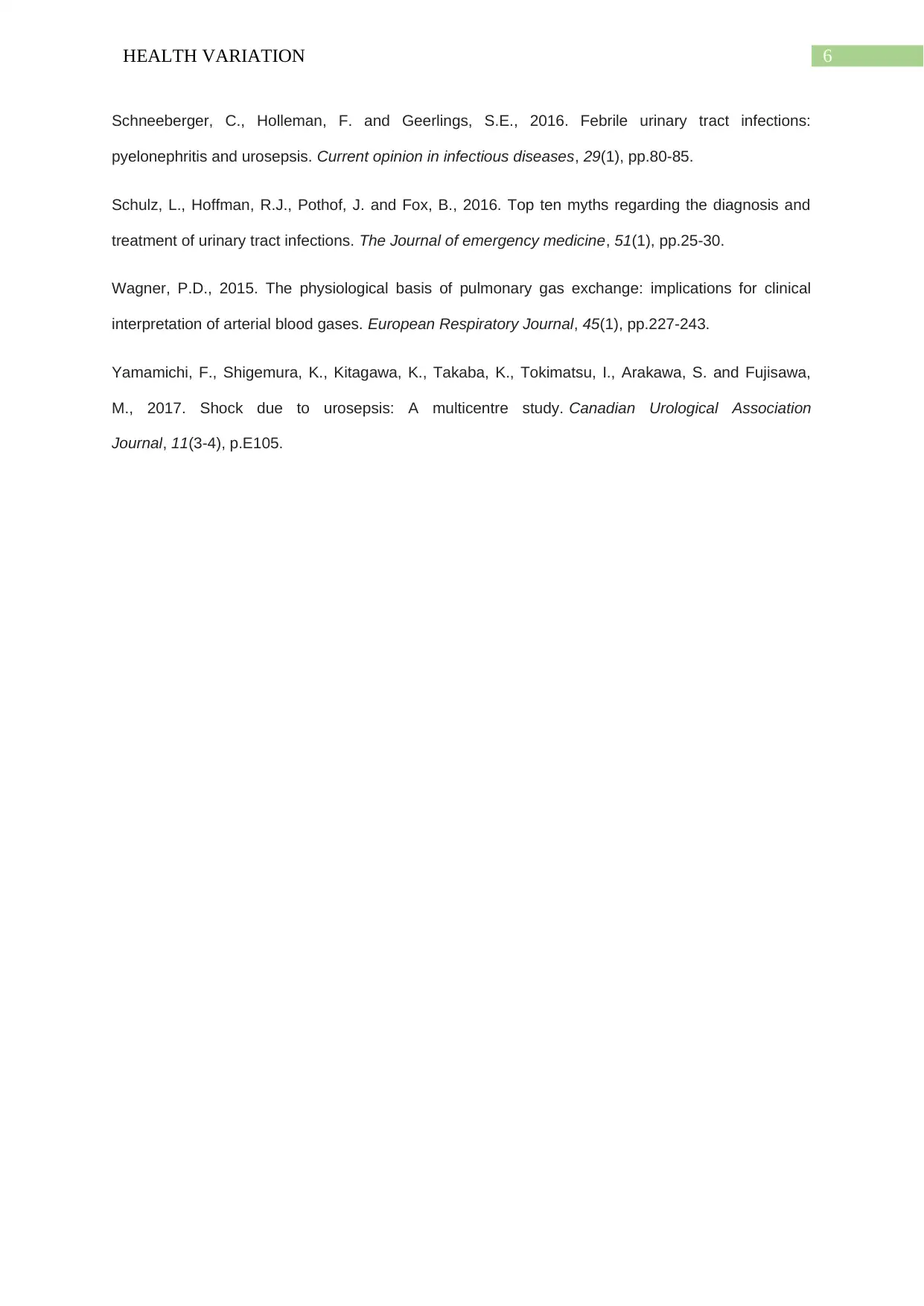
6HEALTH VARIATION
Schneeberger, C., Holleman, F. and Geerlings, S.E., 2016. Febrile urinary tract infections:
pyelonephritis and urosepsis. Current opinion in infectious diseases, 29(1), pp.80-85.
Schulz, L., Hoffman, R.J., Pothof, J. and Fox, B., 2016. Top ten myths regarding the diagnosis and
treatment of urinary tract infections. The Journal of emergency medicine, 51(1), pp.25-30.
Wagner, P.D., 2015. The physiological basis of pulmonary gas exchange: implications for clinical
interpretation of arterial blood gases. European Respiratory Journal, 45(1), pp.227-243.
Yamamichi, F., Shigemura, K., Kitagawa, K., Takaba, K., Tokimatsu, I., Arakawa, S. and Fujisawa,
M., 2017. Shock due to urosepsis: A multicentre study. Canadian Urological Association
Journal, 11(3-4), p.E105.
Schneeberger, C., Holleman, F. and Geerlings, S.E., 2016. Febrile urinary tract infections:
pyelonephritis and urosepsis. Current opinion in infectious diseases, 29(1), pp.80-85.
Schulz, L., Hoffman, R.J., Pothof, J. and Fox, B., 2016. Top ten myths regarding the diagnosis and
treatment of urinary tract infections. The Journal of emergency medicine, 51(1), pp.25-30.
Wagner, P.D., 2015. The physiological basis of pulmonary gas exchange: implications for clinical
interpretation of arterial blood gases. European Respiratory Journal, 45(1), pp.227-243.
Yamamichi, F., Shigemura, K., Kitagawa, K., Takaba, K., Tokimatsu, I., Arakawa, S. and Fujisawa,
M., 2017. Shock due to urosepsis: A multicentre study. Canadian Urological Association
Journal, 11(3-4), p.E105.
1 out of 7
Related Documents
Your All-in-One AI-Powered Toolkit for Academic Success.
+13062052269
info@desklib.com
Available 24*7 on WhatsApp / Email
![[object Object]](/_next/static/media/star-bottom.7253800d.svg)
Unlock your academic potential
© 2024 | Zucol Services PVT LTD | All rights reserved.





